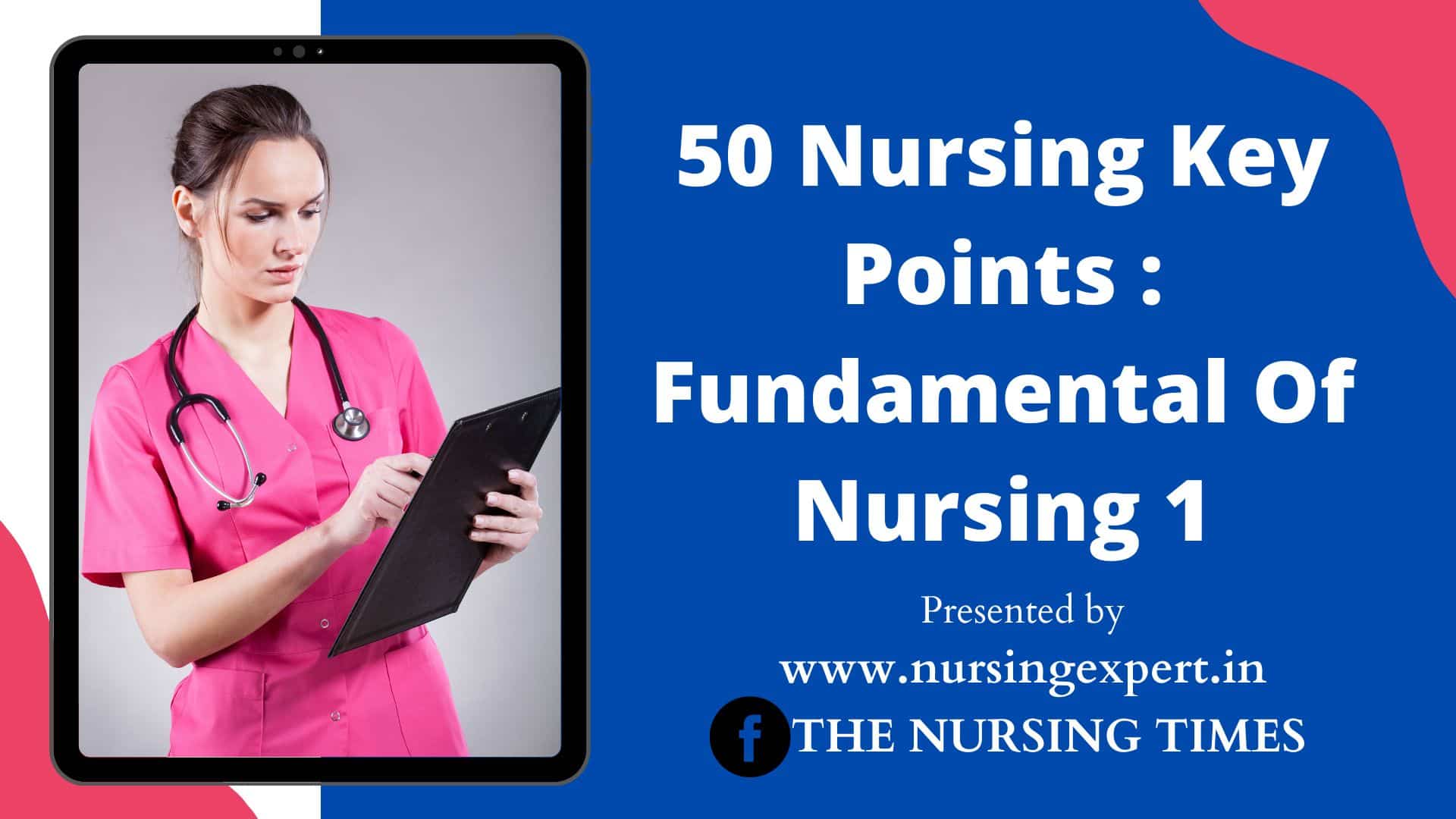Here is a comprehensive collection of nursing key points and concepts to keep in mind before any competitive test. Short sentences and a straight-to-the-point arrangement are used to group key points into subject categories. Nursing Key Points : Fundamental of Nursing IV
Thank you for reading this post, don't forget to subscribe!

- When measuring blood pressure in an obese patient, the nurse should utilise a leg cuff.
- The measurement will be inaccurately raised if a blood pressure cuff is put too loosely.
- Ptosis is the drooping of the upper eyelid.
- A tilt table is beneficial for a patient with a spinal cord injury, orthostatic hypotension, or brain damage because it can gently shift the patient from a horizontal to an upright posture.
- When performing venipuncture, the nurse should tilt the bevel upward when the vessel’s lumen is bigger than the needle and downward when the lumen is only slightly larger than the needle.
- The nurse should do the following procedures to bring a patient to the edge of the bed for transfer: Move the patient’s head and shoulders to the bed’s edge. Bring the patient’s feet and legs to the bed’s edge (crescent position). Straighten the back and move the patient toward the edge of the bed with both arms well under the patient’s hips.
- A patient should wear shoes when getting measured for crutches.
- A restraint should be attached to the section of the bed frame that moves with the head, not to the mattress or side rails.
- The mist in a mist tent should never get so dense that it obscures the patient’s breathing rhythm.
- To deliver heparin subcutaneously, the nurse should do the following: Clean the area with alcohol, but do not massage it. Pick up a well-defined skin fold or stretch the skin taut. Hold the needle shaft in a dart position. Insert the needle at a right (90-degree) angle into the skin. Depress the plunger firmly but do not aspirate. Allow the needle to remain in position for 10 seconds. Withdraw the needle carefully at the insertion angle. Using an alcohol pad, apply pressure to the injection site.
- The nurse should place the patient in the knee-chest position or Sims’ position for a sigmoidoscopy, depending on the physician’s choice.
- Maslow’s hierarchy of needs states that physiologic needs (oxygen, food, water, sex, rest, and comfort), safety and security, love and belonging, self-esteem and recognition, and self-actualization must be met in the following order: physiologic (oxygen, food, water, sex, rest, and comfort), safety and security, love and belonging, self-esteem and recognition
- To prevent pain in a patient with a nasogastric tube, the nurse should apply a water-soluble lubricant to the nose.
- A nasogastric tube is introduced during gastric lavage, the stomach is flushed, and ingested items are evacuated through the tube.
- The nurse should specify the amount, colour, and consistency of the drainage when noting it on a surgical dressing (for example, “10 mm of brown mucoid discharge observed on dressing”).
- The nurse rubs the sole of the patient’s foot with a fairly pointed instrument, such as a thumbnail, to elicit Babinski’s reaction.
- A good thing Babinski’s reflex is characterised by dorsiflexion of the great toe and toe fanning out.
- When examining a patient for bladder distention, the nurse should look for a spherical mass over the symphysis pubis in the lower abdomen.
- Repositioning the bedridden patient at least every 2 hours is the most effective strategy to prevent pressure ulcers.
- Antiembolism stockings reduce the risk of thrombus development by decompressing the superficial blood vessels.
- A blood pressure cuff that is too small might result in an incorrectly raised blood pressure measurement.
- When preparing a single injection for a patient who uses both regular and neutral protein Hagedorn insulin, the nurse should first draw the regular insulin into the syringe to avoid contaminating the regular insulin.
- Rhonchi are rumbling noises detected during lung auscultation. They are more noticeable during expiration than inspiration.
- Gavage is a type of forced feeding that is commonly done using a gastric tube (a tube passed into the stomach through the mouth).
- Physiologic requirements (air, water, food, shelter, sex, exercise, and comfort) take the greatest priority in Maslow’s hierarchy of needs.
- The safest and surest way to verify a patient’s identity is to check the identification band on his wrist.
- In the therapeutic environment, the patient’s safety is the primary concern.
- Fluid oscillation in the tubing of a chest drainage system indicates that the system is working properly.
- The nurse should place a patient who has a Sengstaken-Blakemore tube in semi-Fowler position.
- The nurse can elicit Trousseau’s sign by occluding the brachial or radial artery. Hand and finger spasms that occur during occlusion indicate Trousseau’s sign and suggest hypocalcemia.
- The needle size for blood transfusion in an adult is 16 to 20G.
- Intractable pain is defined as pain that incapacitates a patient and cannot be eased by medication.
- In an emergency, treatment permission can be obtained through fax, phone, or other telegraphic methods.
- The decibel is the unit of sound measurement.
- Any intrusive surgery requires informed permission.
- To grant consent for treatment, a patient who is unable to sign his name must form an X in the presence of two witnesses, such as a nurse, priest, or physician.
- The Z-track intramuscular injection method locks the medication deep into the muscle, reducing skin discomfort and discoloration. It requires a needle that is at least 1 inch (2.5 cm) length.
- RACE is the most commonly used abbreviation in the case of a fire. (R) Take the patient out. (A) Set off the alarm. (C) Close the door to try to put out the fire. (E) If possible, extinguish the fire safely.
- A registered nurse should delegate bedside care, such as suctioning and medication administration, to a licenced vocational nurse or licenced practical nurse.
- When using a cane, the patient should carry it on the unaffected side and advance it together with the afflicted extremity.
- The nurse should measure from the axilla to the sole and add 2′′ (5 cm) to that amount when fitting a supine patient for crutches.
- The nurse’s first interaction with the patient begins the assessment process, which continues during the patient’s stay. The evaluation data is obtained by the nurse through the health history, physical examination, and review of diagnostic investigations.
- The needle used for insulin injection is 25G and 5/8′′ long.
- The urine that stays in the bladder after urinating is known as residual urine. The amount of leftover urine is usually between 50 and 100 mL.
- Assessment, nursing diagnosis, planning, implementation, and evaluation are the five steps of the nursing process.
- The step of the nursing process in which the nurse constantly collects data to determine a patient’s present and prospective health requirements is known as assessment.
- The step of the nursing process in which the nurse makes a clinical judgement regarding individual, family, or community reactions to current or anticipated health issues or life processes is known as nursing diagnosis.
- The stage of the nursing process in which the nurse assigns priorities to nursing diagnoses, specifies short-term and long-term goals and expected outcomes, and prepares the nursing care plan is known as planning.
- The step of the nursing process in which the nurse puts the nursing care plan into action, delegate specific nursing interventions to members of the nursing team, and track patient responses to nursing interventions is known as implementation.
- If a patient is unable to urinate, the initial nursing activity should be bladder palpation to determine bladder distention.



